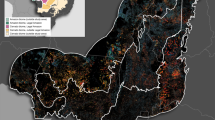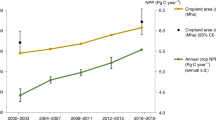Abstract
A prominent goal of policies mitigating climate change and biodiversity loss is to achieve zero deforestation in the global supply chain of key commodities, such as palm oil and soybean. However, the extent and dynamics of deforestation driven by commodity expansion are largely unknown. Here we mapped annual soybean expansion in South America between 2000 and 2019 by combining satellite observations and sample field data. From 2000 to 2019, the area cultivated with soybean more than doubled from 26.4 Mha to 55.1 Mha. Most soybean expansion occurred on pastures originally converted from natural vegetation for cattle production. The most rapid expansion occurred in the Brazilian Amazon, where soybean area increased more than tenfold, from 0.4 Mha to 4.6 Mha. Across the continent, 9% of forest loss was converted to soybean by 2016. Soybean-driven deforestation was concentrated at the active frontiers, nearly half located in the Brazilian Cerrado. Efforts to limit future deforestation must consider how soybean expansion may drive deforestation indirectly by displacing pasture or other land uses. Holistic approaches that track land use across all commodities coupled with vegetation monitoring are required to maintain critical ecosystem services.
This is a preview of subscription content, access via your institution
Access options
Access Nature and 54 other Nature Portfolio journals
Get Nature+, our best-value online-access subscription
$29.99 / 30 days
cancel any time
Subscribe to this journal
Receive 12 digital issues and online access to articles
$119.00 per year
only $9.92 per issue
Buy this article
- Purchase on Springer Link
- Instant access to full article PDF
Prices may be subject to local taxes which are calculated during checkout





Similar content being viewed by others
Data availability
The annual soybean maps generated in this study can be viewed and downloaded at https://glad.earthengine.app/view/south-america-soybean and https://glad.umd.edu/projects/commodity-crop-mapping-and-monitoring-south-america. Forest change maps are available at https://glad.earthengine.app/view/global-forest-change.
Code availability
Satellite-based soybean classification was carried out using the GLAD Landsat Analysis Ready Data and Tools52 available at https://glad.geog.umd.edu/ard/home. Custom code for analysing soybean-driven deforestation is available from corresponding authors upon reasonable request.
References
Tilman, D., Balzer, C., Hill, J. & Befort, B. L. Global food demand and the sustainable intensification of agriculture. Proc. Natl Acad. Sci. USA 108, 20260–20264 (2011).
Foley, J. A. et al. Global consequences of land use. Science 309, 570–574 (2005).
Hansen, M. C. et al. High-resolution global maps of 21st-century forest cover change. Science 342, 850–853 (2013).
Song, X.-P. et al. Global land change from 1982 to 2016. Nature 560, 639–643 (2018).
Curtis, P. G., Slay, C. M., Harris, N. L., Tyukavina, A. & Hansen, M. C. Classifying drivers of global forest loss. Science 361, 1108–1111 (2018).
Pimm, S. L. et al. The biodiversity of species and their rates of extinction, distribution, and protection. Science 344, 1246752 (2014).
Graesser, J., Ramankutty, N. & Coomes, O. T. Increasing expansion of large-scale crop production onto deforested land in sub-Andean South America. Environ. Res. Lett. 13, 084021 (2018).
Zalles, V. et al. Near doubling of Brazil’s intensive row crop area since 2000. Proc. Natl Acad. Sci. USA 116, 428–435 (2019).
FAOSTAT (FAO, 2019); http://www.fao.org/faostat
Cassman, K. G. & Grassini, P. A global perspective on sustainable intensification research. Nat. Sustain. 3, 262–268 (2020).
Fuchs, R. et al. Why the US–China trade war spells disaster for the Amazon. Nature 567, 451–454 (2019).
Lambin, E. F. et al. The role of supply-chain initiatives in reducing deforestation. Nat. Clim. Change 8, 109–116 (2018).
Rudorff, B. F. T. et al. The soy moratorium in the Amazon biome monitored by remote sensing images. Remote Sens. 3, 185–202 (2011).
Gibbs, H. K. et al. Brazil’s soy moratorium. Science 347, 377–378 (2015).
Kastens, J. H., Brown, J. C., Coutinho, A. C., Bishop, C. R. & Esquerdo, J. Soy moratorium impacts on soybean and deforestation dynamics in Mato Grosso, Brazil. PLoS ONE 12, e0176168 (2017).
Gollnow, F., Hissa, Ld. B. V., Rufin, P. & Lakes, T. Property-level direct and indirect deforestation for soybean production in the Amazon region of Mato Grosso, Brazil. Land Use Policy 78, 377–385 (2018).
Rausch, L. L. et al. Soy expansion in Brazil’s Cerrado. Conserv. Lett. https://doi.org/10.1111/conl.12671 (2019).
Spera, S. A., Galford, G. L., Coe, M. T., Macedo, M. N. & Mustard, J. F. Land-use change affects water recycling in Brazil’s last agricultural frontier. Glob. Change Biol. 22, 3405–3413 (2016).
Noojipady, P. et al. Forest carbon emissions from cropland expansion in the Brazilian Cerrado biome. Environ. Res. Lett. 12, 025004 (2017).
Soterroni, A. C. et al. Expanding the soy moratorium to Brazil’s Cerrado. Sci. Adv. 5, eaav7336 (2019).
Rajão, R. et al. The rotten apples of Brazil’s agribusiness. Science 369, 246–248 (2020).
Heilmayr, R., Rausch, L. L., Munger, J. & Gibbs, H. K. Brazil’s Amazon soy moratorium reduced deforestation. Nat. Food 1, 801–810 (2020).
Cerrado Manifesto. The Future of the Cerrado in the Hands of the Market: Deforestation and Native Vegetation Conversion Must Be Stopped (2017); http://d3nehc6yl9qzo4.cloudfront.net/downloads/cerradoconversionzero_sept2017_2.pdf
Meyfroidt, P. et al. Multiple pathways of commodity crop expansion in tropical forest landscapes. Environ. Res. Lett. 9, 074012 (2014).
PRODES (INPE, 2019); http://www.obt.inpe.br/OBT/assuntos/programas/amazonia/prodes
Turubanova, S., Potapov, P. V., Tyukavina, A. & Hansen, M. C. Ongoing primary forest loss in Brazil, Democratic Republic of the Congo, and Indonesia. Environ. Res. Lett. 13, 074028 (2018).
Argentina: Oilseeds and Products Annual (USDA Foreign Agricultural Service, 2016).
Nepstad, D. et al. Slowing Amazon deforestation through public policy and interventions in beef and soy supply chains. Science 344, 1118–1123 (2014).
Seymour, F. & Harris, N. L. Reducing tropical deforestation. Science 365, 756–757 (2019).
Richards, P. D., Walker, R. T. & Arima, E. Y. Spatially complex land change: the indirect effect of Brazil’s agricultural sector on land use in Amazonia. Glob. Environ. Change 29, 1–9 (2014).
Gasparri, N. I. & le Polain de Waroux, Y. The coupling of South American soybean and cattle production frontiers: new challenges for conservation policy and land change science. Conserv. Lett. 8, 290–298 (2015).
Fehlenberg, V. et al. The role of soybean production as an underlying driver of deforestation in the South American Chaco. Glob. Environ. Change 45, 24–34 (2017).
le Polain de Waroux, Y. et al. The restructuring of South American soy and beef production and trade under changing environmental regulations. World Dev. 121, 188–202 (2019).
Tyukavina, A. et al. Types and rates of forest disturbance in Brazilian Legal Amazon, 2000–2013. Sci. Adv. 3, e1601047 (2017).
De Sy, V. et al. Land use patterns and related carbon losses following deforestation in South America. Environ. Res. Lett. 10, 124004 (2015).
Fearnside, P. M. Soybean cultivation as a threat to the environment in Brazil. Environ. Conserv. 28, 23–38 (2002).
Barona, E., Ramankutty, N., Hyman, G. & Coomes, O. T. The role of pasture and soybean in deforestation of the Brazilian Amazon. Environ. Res. Lett. https://doi.org/10.1088/1748-9326/5/2/024002 (2010).
Macedo, M. N. et al. Decoupling of deforestation and soy production in the southern Amazon during the late 2000s. Proc. Natl Acad. Sci. USA 109, 1341–1346 (2012).
Alexandratos, N. & Bruinsma, J. World Agriculture Towards 2030/2050: the 2012 Revision (FAO, 2012).
Brandão, A. Jr et al. Estimating the potential for conservation and farming in the Amazon and Cerrado under four policy scenarios. Sustainability https://doi.org/10.3390/su12031277 (2020).
Martini, D. Z., Moreira, M. A., Cruz de Aragão, L. E. Oe, Formaggio, A. R. & Dalla-Nora, E. L. Potential land availability for agricultural expansion in the Brazilian Amazon. Land Use Policy 49, 35–42 (2015).
Hunke, P., Mueller, E. N., Schröder, B. & Zeilhofer, P. The Brazilian Cerrado: assessment of water and soil degradation in catchments under intensive agricultural use. Ecohydrology 8, 1154–1180 (2014).
Nosetto, M. D., Paez, R. A., Ballesteros, S. I. & Jobbágy, E. G. Higher water-table levels and flooding risk under grain vs. livestock production systems in the subhumid plains of the Pampas. Agric. Ecosyst. Environ. 206, 60–70 (2015).
Schulz, C. et al. Physical, ecological and human dimensions of environmental change in Brazil’s Pantanal wetland: synthesis and research agenda. Sci. Total Environ. 687, 1011–1027 (2019).
Weinhold, D., Killick, E. & Reis, E. J. Soybeans, poverty and inequality in the Brazilian Amazon. World Dev. 52, 132–143 (2013).
Garrett, R. D. & Rausch, L. L. Green for gold: social and ecological tradeoffs influencing the sustainability of the Brazilian soy industry. J. Peasant Stud. 43, 461–493 (2016).
Oliveira, G. & Hecht, S. Sacred groves, sacrifice zones and soy production: globalization, intensification and neo-nature in South America. J. Peasant Stud. 43, 251–285 (2016).
Garrett, R. D. et al. Intensification in agriculture-forest frontiers: land use responses to development and conservation policies in Brazil. Glob. Environ. Change 53, 233–243 (2018).
Song, X.-P. et al. National-scale soybean mapping and area estimation in the United States using medium resolution satellite imagery and field survey. Remote Sens. Environ. 190, 383–395 (2017).
King, L. et al. A multi-resolution approach to national-scale cultivated area estimation of soybean. Remote Sens. Environ. 195, 13–29 (2017).
Potapov, P. et al. Annual continuous fields of woody vegetation structure in the Lower Mekong region from 2000-2017 Landsat time-series. Remote Sens. Environ. 232, 111278 (2019).
Potapov, P. et al. Landsat analysis ready data for global land cover and land cover change mapping. Remote Sens. 12, 426 (2020).
Global Forest Resources Assessment 2015 (FAO, 2015).
Brazil’s Submission of a Forest Reference Emission Level (FREL) for Reducing Emissions from Deforestation in the Amazonia Biome for REDD+ Results-Based Payments Under the UNFCCC from 2016 to 2020 (Ministry of Environment of Brazil, 2018); https://redd.unfccc.int/files/2018_frel_submission_brazil.pdf
Olson, D. M. et al. Terrestrial ecoregions of the world: a new map of life on Earth. BioScience 51, 933–938 (2001).
Morton, D. C. et al. Cropland expansion changes deforestation dynamics in the southern Brazilian Amazon. Proc. Natl Acad. Sci. USA 103, 14637–14641 (2006).
Acknowledgements
This study was funded by the Gordon and Betty Moore Foundation (7864, M.C.H.), the NASA Land-Cover and Land-Use Change Program (NNX15AK65G, M.C.H. and 80NSSC20K1490, X.-P.S.), the USGS Landsat Science Team (140G0118C0013, M.C.H.) and the NASA Harvest Program (80NSSC18M0039, M.C.H.). M.A. was supported by CNPq (National Council for Scientific and Technological Development) Grant 306334/2020-8. We thank F. Monti, D. Saúl and P. Oricchio for assisting with field data collection in Argentina. We thank V. F. Reno and L. V. Oldoni for assisting with field data collection in Brazil.
Author information
Authors and Affiliations
Contributions
X.-P.S. and M.C.H. designed the study; X.-P.S., P.P., B.A., J.P., M.A., A.L. and V.Z. conducted satellite data analysis; S.V.S. and A.T. contributed ideas for statistical design and area estimation; X.-P.S., M.C.H., P.P., J.P., M.A., A.L., V.Z., C.M.D.B., M.C.C., E.J.C., L.B.F., A.H.-S., S.M.J., A.H.P. and S.T. collected field data. A.H.P. designed online data visualization. M.C.H. secured funding support. X.-P.S. wrote the initial draft with substantial input from M.C.H., S.V.S. and M.A. All authors commented on drafts.
Corresponding authors
Ethics declarations
Competing interests
The authors declare no competing interests.
Additional information
Peer review information Nature Sustainability thanks the anonymous reviewers for their contribution to the peer review of this work.
Publisher’s note Springer Nature remains neutral with regard to jurisdictional claims in published maps and institutional affiliations.
Supplementary information
Supplementary Information
Supplementary Figs. 1–8 and Tables 1 and 2.
Rights and permissions
About this article
Cite this article
Song, XP., Hansen, M.C., Potapov, P. et al. Massive soybean expansion in South America since 2000 and implications for conservation. Nat Sustain 4, 784–792 (2021). https://doi.org/10.1038/s41893-021-00729-z
Received:
Accepted:
Published:
Issue Date:
DOI: https://doi.org/10.1038/s41893-021-00729-z
This article is cited by
-
Telecoupled impacts of the Russia–Ukraine war on global cropland expansion and biodiversity
Nature Sustainability (2024)
-
Leverage points for tackling unsustainable global value chains: market-based measures versus transformative alternatives
Sustainability Science (2024)
-
Large-scale crops are sources of polyphagous pest populations for small farmers at the landscape level: an isotope tracing model
Journal of Pest Science (2024)
-
Accessing the specialized metabolome of actinobacteria from the bulk soil of Paullinia cupana Mart. on the Brazilian Amazon: a promising source of bioactive compounds against soybean phytopathogens
Brazilian Journal of Microbiology (2024)
-
European soybean to benefit people and the environment
Scientific Reports (2024)



